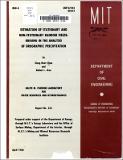| dc.contributor.author | Chua, Siong Huat | en_US |
| dc.contributor.author | Bras, Rafael L. | en_US |
| dc.date.accessioned | 2022-06-13T13:08:23Z | |
| dc.date.available | 2022-06-13T13:08:23Z | |
| dc.date.issued | 1980-04 | |
| dc.identifier | 255 | |
| dc.identifier.uri | https://hdl.handle.net/1721.1/142998 | |
| dc.description | Prepared under support of the Dept. of Energy through M.I.T. Energy Laboratory and the Office of Surface Mining, Dept. of the Interior, through M.I.T.'s Mining and Mineral Resources Research Institute, Grant no. G5195022 | en_US |
| dc.description.abstract | The theory of kriging, an optimal linear estimation technique for spatial stochastic processes, is presented and applied to the estimation of mean areal precipitation under stationary and non-stationary mean assumptions. In the stationary mean cases, the alternate use of semivariograms and covariances was investigated in conjunction with the adoption of a single realization versus a multirealization approach to defining the ensemble of events. Results favor the multirealization approach. The issue of the choice of covariogram model and optimization procedure appears questionable for the stationary mean case since traditional subjective areal averaging methods do as well as kriging. For non-stationary mean cases, assumed for storms in regions under orographic influence, kriging results with generalized covariances, identified under the necessary assumptions for intrinsic random functions of order k, were compared with a "detrending" procedure postulating a deterministic drift linearly related to ground elevation. The latter procedure gave more accurate kriging estimates but did not perform as well in representing the kriging estimation error variance. Generally, results point to the feasibility and attractiveness of kriging methods for MAP estimation, especially for non-stationary mean storms. The present work shows the need for further investigation in covariogram model inference and the effect of model errors on kriging results, particularly on the kriging estimation error variance. | en_US |
| dc.publisher | Cambridge, Mass. : Massachusetts Institute of Technology, Dept. of Civil Engineering, Ralph M. Parsons Laboratory for Water Resources and Hydrodynamics | |
| dc.relation.ispartofseries | R (Massachusetts Institute of Technology. Department of Civil Engineering) ; 80-6. | |
| dc.relation.ispartofseries | Report (Ralph M. Parsons Laboratory for Water Resources and Hydrodynamics) ; 255. | |
| dc.title | Estimation of Stationary and Non-stationary Random Fields: Kriging in the Analysis of Orographic Precipitation | en_US |
| dc.identifier.oclc | 6673032 | |
| dc.identifier.aleph | 92375 | |
